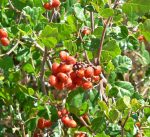 Native to the grasslands, shrubland, deserts, and forests of Western US from Washington to California, east to the Dakotas and Texas, this suckering deciduous shrub is known by many names including skunkbush, stinking sumac, squawbush, lemonade sumac, polecat bush, quailbush, basketbush, and sourberry. It is a member of the cashew family, Anacardiaceae, that also includes smoke tree, mango, and poison ivy. Plants grow 3-8′ tall and have arching stems and pinnately compound dark green leaves with three leaflets that are 1.5″ long, coarsely toothed, and turn orange-red in the fall. The leaves are aromatic but the scent is disagreeable to some and gave rise to the common names like skunkbush and stinking sumac. In spring before the leaves appear catkins of male and female flowers are produced on the same or different plants. The male flowers are inconspicuous and yellowish, while the female flowers are bright yellow and carried at the end of branches. The fertilized female flowers give way to small sparsely hairy fruits that persist through fall and winter and are eaten by birds and small mammals when better food is unavailable. In addition, the thickets formed by the plants provide nesting cover and hiding sites for wildlife. Threeleaf sumac is one of the most drought tolerant sumacs and is useful for erosion control, xeriscape, windbreak and a hedge. The genus name, Rhus, is the Greek name for one species, Rhus coriaria. The specific epithet, trilobate, comes from the Latin prefex tri- meaning three, and the Latin word lobatus meaning lobed, and refers to the leaves.
Native to the grasslands, shrubland, deserts, and forests of Western US from Washington to California, east to the Dakotas and Texas, this suckering deciduous shrub is known by many names including skunkbush, stinking sumac, squawbush, lemonade sumac, polecat bush, quailbush, basketbush, and sourberry. It is a member of the cashew family, Anacardiaceae, that also includes smoke tree, mango, and poison ivy. Plants grow 3-8′ tall and have arching stems and pinnately compound dark green leaves with three leaflets that are 1.5″ long, coarsely toothed, and turn orange-red in the fall. The leaves are aromatic but the scent is disagreeable to some and gave rise to the common names like skunkbush and stinking sumac. In spring before the leaves appear catkins of male and female flowers are produced on the same or different plants. The male flowers are inconspicuous and yellowish, while the female flowers are bright yellow and carried at the end of branches. The fertilized female flowers give way to small sparsely hairy fruits that persist through fall and winter and are eaten by birds and small mammals when better food is unavailable. In addition, the thickets formed by the plants provide nesting cover and hiding sites for wildlife. Threeleaf sumac is one of the most drought tolerant sumacs and is useful for erosion control, xeriscape, windbreak and a hedge. The genus name, Rhus, is the Greek name for one species, Rhus coriaria. The specific epithet, trilobate, comes from the Latin prefex tri- meaning three, and the Latin word lobatus meaning lobed, and refers to the leaves.
Type: Deciduous shrub
Outstanding Feature: Flowers, berries
Form: Rounded
Growth Rate: Slow to moderate
Bloom: Catkins of yellowish male and bright yellow female flowers in spring before the leaves appear
Size: 3-8′ H x 3-8′ W
Light: Full sun to light shade
Soil: Average, dry to mediummoist, well-drained
Hardiness: Zones 3-8
Care: Contain as desired
Pests and Diseases: None of significance
Propagation: Treated seeds, root cuttings, layering, softwood cuttings in late spring or early summer, division
Photo Credit: Wikimedia Commons